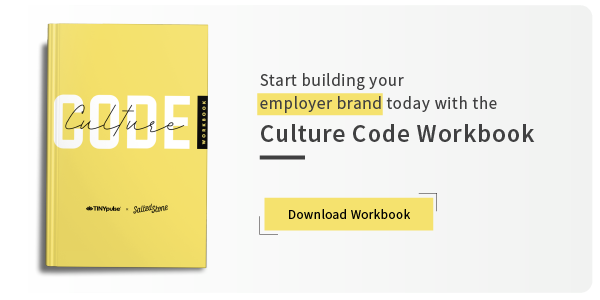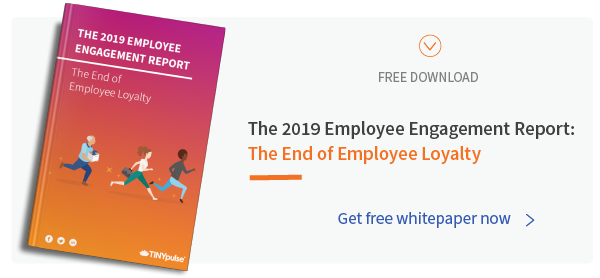Increase Your Employee Survey Response Rate In One Email
Believe it or not, the average employee survey response rate is just 30% to 40%. If you have similar response rates, you pr
obably know how problematic this can be.
Low response rates like this often lead to less reliable results. This makes it difficult to make data-driven decisions as a leader.
So, what causes low survey response rates?
Sometimes, it’s the survey design itself. It’s too long, too vague, or confusing and employees don’t finish it.
Other times, it’s because employees don’t pay attention to the survey invitation email. Through this lens, your survey invitation email can make or break your response rate.
How to optimize your survey invitation email
As any marketer will tell you, a successful email marketing campaign gives you real results. You can use the same strategies to optimize your survey invitation email and get more responses from employees.
Craft a compelling subject line
Before your employees decide to take your survey, they need to open your email. But that’s not always as easy as it sounds.
Only 65% of internal emails are ever opened. If your employees don’t open your email, they won’t hear your message. It’s that simple.
If you have an email marketing solution that allows you to personalize your messages, by all means do it. By using your employees’ names, you can increase your open rate by as much as 26%. Not bad!
How to optimize your subject line to increase open rate
An optimized subject line increases the odds of your employees opening your email. Your subject lines should be clear, engaging, and include a compelling call to action.
If you send your email from your work email account, you don’t need to include your company name in the subject line. Save the space for a more engaging message.
Sample survey invitation subject lines
|
Standard Subject Lines |
Optimized Subject Lines |
|
Let your voice be heard. We value your opinion |
Tyson - Got 5 minutes? Help improve our workplace |
|
The annual Company X employee survey is now open. |
Jane - Want a better workplace? Tell us how we’re doing |
|
It’s time to take Company X’s employee survey |
Darren - What’s it like to work here? Share your experience |
These optimized email subject lines work because our brains are hardwired to spot questions.
Asking a question engages your employees. Coupled with a strong call to action, your employees are more likely to open the email to learn more.
What kind of employee survey invitation email will increase response rate?
Have you ever received an email that is just a wall of text? If so, you likely know how difficult it is to read these types of messages.
Not a copywriter? Don’t worry. You can improve your survey invitation email by using research-backed techniques.
READ NOW: ASK THE RIGHT SURVEY QUESTION: 50 ESSENTIAL EMPLOYEE FEEDBACK SURVEY QUESTIONS
Use an active voice in your survey invitation
Throughout your survey invitation, try to use an active voice instead of a passive one. This makes it easier for your employees to understand your message and take action.
When you use an active voice, the subject performs the action. In the passive voice, they receive the action.
In some cases — like when the subject is unknown or unimportant — the passive voice might work fine. But for the most part, it’s better to use an active voice when you can.
Sample sentences to use in your employee survey invitation email
I’ve included some examples of common passive sentences used in survey invitations and their active counterparts.
Can you see the difference? By sticking to an active voice, your message becomes more clear and concise.
|
Passive |
Active |
|
“On Oct. 10, 2020, the survey will be closing” |
“Our survey closes on Oct. 10, 2020.” |
|
“Improvements will be made using the survey data.” |
“Your feedback will lead to our next improvements.” |
|
“The survey was filled out by 65% of employees last time.” |
“Sixty-five percent of employees filled out the survey last time.” |
Use shorter sentences in your survey invitations
The American Press Institute found that 90% of people can understand 8 to 14 word sentences. Any longer and the comprehension rate drops tremendously.
To make your sentences shorter, try to break up longer ones and cut out unnecessary words. Using an active voice will help. But, for the best results, you also need to pay attention to every word.
"You achieve plain English when you use the simplest, most straightforward way of expressing an idea."
—Bryan Garner, author of Legal Writing in Plain English
Be careful that you aren’t redundant. For example, instead of saying “it’s extremely essential,” just say “it’s essential.”
Talk to your employees and use words like “we” and “you” so your email sounds like it’s coming from a real person.
READ MORE: THE ULTIMATE GUIDE TO EMPLOYEE SURVEY
How to improve your survey invitation email
I’ve added an example below showing how you can use these techniques to shorten a sentence. With these changes, a 38-word sentence becomes two sentences totaling 26 words.
|
Original |
“After the survey closes, we will be carefully considering all of the survey findings and will be reporting back to you on our findings and how we intend to resolve any issues uncovered during the analysis we performed.” |
|
Simplified |
“After the survey closes, expect to hear from us. We will review the results and share how we will address any issues we find.” |
Keep your paragraphs short
To make your survey invitation even easier to read, look carefully at your paragraph length.
You may have learned in the past that every paragraph needs at least three sentences. But in today’s technological world, that’s no longer the case.
Your employees will be reading their survey invitation on an electronic device. Do them a favor and leave plenty of white space.
Ideally, you should keep paragraphs to no more than five lines. The problem is, this varies by device.
If your employees check emails on a phone or tablet, consider sticking to three line paragraphs. You can also use headings to break up your content even more.
Call out important information in your survey invitation
When you write your survey email, make sure you highlight information your employees need to know. This usually includes the survey closing date and how long it will take for your employees to complete.
Any easy way you can do this is to use bold or italics. Just stay away from ALL CAPS or underlined text that can look like links. These can be confusing and hard to read.
Write an employee survey invitation email that gets responses
The average attention span is just eight seconds. When you write your survey invitation email, you’ll want to structure it for maximum impact.
The most effective structure consists of three parts:
The headline: Get them interested
Your subject line got them to open your email, now it’s time to get them to care. You can do this by putting the most relevant and important information upfront.
Start by letting them know:
- What the survey is
- Who should take it
- Why they will benefit
By putting this information upfront, your employees will be more likely to continue reading.
The supporting text: Tell them what they need to know
The second part of your email is your supporting text. This information will help your employees better understand what’s required of them.
It will also provide more context and answer questions your employees may have.
Survey deadlineThe survey deadline is a crucial piece of information for your employees.
Traditionally, many survey invitation emails put the date at the end of the email. But this makes it easy to overlook. Try to include it toward the beginning of your email.
Estimated time to complete the survey
Research has shown that employees get fatigue after just 20 minutes of taking surveys. Including an estimated completion time allows your employees to mentally prepare.
If you have a shorter survey, including an estimate makes it less likely that your employees will delay or avoid taking your survey.
READ NOW: HOW OFTEN SHOULD YOU RUN EMPLOYEE SURVEYS
Response anonymity and confidentiality
More than 75% of survey respondents want to remain anonymous. If your employees’ responses will be anonymous, let them know.
If their responses aren’t anonymous, explain that the responses are confidential. When organizations use confidential surveys, it’s often to get better insight into responses.
The problem with anonymous responses is that you can’t follow up with the respondent. This is especially difficult if you need to clarify quantifiable data.
Tools like TINYpulse give you a way to follow up anonymously with your employees. If you use private messages, let your employees know you may follow up with them. Assure them any communication is still anonymous.
Plans for reviewing the data and taking action
You’ve already shared with your employees why they should take the survey. Tie your email together by explaining your plan for reviewing the results. Let them know they can expect to see the survey results.
The call to action: Show them what to do
Close your email with your call to action and survey link. To get the most responses, make sure your call to action is clear and stands out.
A bright, high-contrast button is a great way to do this. Add your email signature and your employee survey invitation is complete.
Employee survey invitation email samples
|
##### Subject: [Name] - Got [est. completion] minutes? Help improve our workplace |
|
[Name], Do you want to help make [company name] a better place to work? We want to make the changes you want to see. By taking the [name of survey], you can help us:
When you have [est. completion] minutes, please take the survey by [mm/dd/yyyy]. All of your responses are 100% anonymous and you can use work time to take it. Once the survey closes, we will review the results. By [mm/dd/yyyy], we will share the results with you. We will also let you know how we plan to address any issues we find. Thank you in advance for helping us make [company name] your employer of choice. If you have questions about the survey, please [contact information]. [email signature] ##### |
Ready to send your survey invitation?
As a leader, you probably know the importance of having the right data.
A higher survey response rate means more reliable results and better insights. This will help you make more informed leadership decisions.
By following the research-backed tips in this article, you can take the guesswork out of asking your employees to take a survey.
The survey itself is a different story.
READ MORE: THE ULTIMATE GUIDE TO EMPLOYEE SURVEY
Need to design a survey your employees want to take?
Discover how TINYpulse can help
With science-backed survey questions and templates, you’ll get results-driven data every time. It’s the easiest way to get the data you need to figure out the best path forward.
Share this
You May Also Like
These Related Stories
Why Anonymous Employee Surveys Fail & What to Do Instead

The Ultimate Guide to Employee Engagement Survey Questions [25 Examples to Get You Started]







.png?width=534&height=632&name=blog%20ad%20(1).png)
